In the highly competitive SUV market, the Ford Kuga and Mazda CX-30 stand out with their unique characteristics and cutting-edge technologies. Both vehicles cater to a demographic that values comfort, performance, and modern innovations. In this article, we take a closer look at how these two SUVs compare across various dimensions.
Ford Kuga vs Mazda CX-30 – Which car suits you better?
Two cars, one duel: Ford Kuga meets Mazda CX-30.
Which one wins in performance, efficiency and value for money? Find out now!
Performance and Engine Options
The Ford Kuga offers a versatile range of engine options, including petrol, full hybrid, and plugin hybrid variants. With power outputs ranging from 150 to 243 HP, the Kuga caters to various driving preferences. The acceleration times vary as well, with the quickest model reaching 0-100 km/h in just 7.3 seconds. The blend of manual and automatic transmissions, paired with options for front-wheel or all-wheel drive, makes the Kuga adaptable to different driving conditions.
In contrast, the Mazda CX-30 relies solely on petrol MHEV (Mild Hybrid Electric Vehicle) engines, with maximum outputs of up to 186 HP. The acceleration is quite competitive, with the top variant also achieving 0-100 km/h in just 8.3 seconds. The CX-30 offers a combination of manual and automatic transmissions, with both front-wheel and all-wheel drive options, appealing to a variety of driving preferences as well.
Fuel Efficiency
Fuel efficiency is a critical aspect for many buyers in the SUV segment. The Ford Kuga’s hybrid models shine with astonishing consumption figures, as low as 0.9 L/100 km for the hybrid variant, illustrating its environmental friendliness. Even the petrol options are reasonably efficient, with consumption ranging from 5.3 to 6.4 L/100 km.
On the other hand, the Mazda CX-30 presents commendable fuel efficiency with consumption figures between 5.7 and 6.6 L/100 km. Though it lacks a hybrid option, the utilization of mild hybrid technology aids in optimizing fuel usage, placing it among the top choices in the segment.
Space and Comfort
Interior space and comfort are crucial in the SUV category. The Ford Kuga boasts a trunk capacity of 412 L, providing ample storage for family outings or shopping trips. Its spacious interior comfortably accommodates five passengers, contributing to an overall pleasant driving experience.
Similarly, the Mazda CX-30 doesn't trail far behind, offering a trunk capacity of 430 L, slightly more than its competitor. The CX-30 is also designed to provide comfort and a stylish atmosphere within its interior, focusing on a driver-centric layout and premium materials.
Advanced Technologies and Safety Features
Both SUVs embrace modern technology, ensuring a suite of features that enhance driving safety and convenience. The Ford Kuga is equipped with Ford's latest infotainment system, which includes a responsive touchscreen display, smartphone integration, and various driver-assistance technologies such as adaptive cruise control, lane-keeping assist, and traffic jam assist, making it a tech-savvy choice.
The Mazda CX-30 matches up with its own array of innovative features, including the Mazda Connect infotainment system, which provides seamless connectivity and navigation, complemented by a comprehensive suite of safety features dubbed i-Activsense. This includes advanced technologies such as smart braking, blind-spot monitoring, and rear cross-traffic alert, enhancing driver confidence on the road.
Conclusion
When it comes to choosing between the Ford Kuga and Mazda CX-30, the decision ultimately depends on individual preferences and needs. The Kuga excels in hybrid options and fuel efficiency while offering robust performance and spaciousness. Conversely, the CX-30 brings appealing design elements, advanced technology integration, and slightly more storage space to the table.
Fans of either brand will find compelling reasons to choose their model of choice. With its balance of power, efficiency, and technological advancement, both the Ford Kuga and Mazda CX-30 are formidable contenders in today’s SUV market.
Here’s where it gets real: The technical differences in detail
Costs and Efficiency:
Price and efficiency are often the first things buyers look at. Here it becomes clear which model has the long-term edge – whether at the pump, the plug, or in purchase price.
Mazda CX-30 has a distinct advantage in terms of price – it starts at 25200 £, while the Ford Kuga costs 34200 £. That’s a price difference of around 9008 £.
Fuel consumption also shows a difference: Ford Kuga manages with 2.80 L and is therefore convincingly more efficient than the Mazda CX-30 with 5.70 L. The difference is about 2.90 L per 100 km.
Engine and Performance:
Under the bonnet, it becomes clear which model is tuned for sportiness and which one takes the lead when you hit the accelerator.
When it comes to engine power, the Ford Kuga has a distinct edge – offering 243 HP compared to 186 HP. That’s roughly 57 HP more horsepower.
In acceleration from 0 to 100 km/h, the Ford Kuga is slightly quicker – completing the sprint in 7.30 s, while the Mazda CX-30 takes 8.30 s. That’s about 1 s faster.
In terms of top speed, the Mazda CX-30 performs barely noticeable better – reaching 204 km/h, while the Ford Kuga tops out at 200 km/h. The difference is around 4 km/h.
Both models offer the same torque – 240 Nm.
Space and Everyday Use:
Beyond pure performance, interior space and usability matter most in daily life. This is where you see which car is more practical and versatile.
Both vehicles offer seating for 5 people.
In curb weight, Mazda CX-30 is hardly perceptible lighter – 1455 kg compared to 1526 kg. The difference is around 71 kg.
In terms of boot space, the Mazda CX-30 offers barely noticeable more room – 430 L compared to 412 L. That’s a difference of about 18 L.
In maximum load capacity, the Ford Kuga performs barely noticeable better – up to 1534 L, which is about 128 L more than the Mazda CX-30.
When it comes to payload, Ford Kuga hardly perceptible takes the win – 550 kg compared to 496 kg. That’s a difference of about 54 kg.
Who comes out on top?
Overall, the Ford Kuga shows itself to be wins the duel decisively and secures the title of DriveDuel Champion.
It convinces with the more balanced overall package and proves to be the more versatile choice for everyday use.
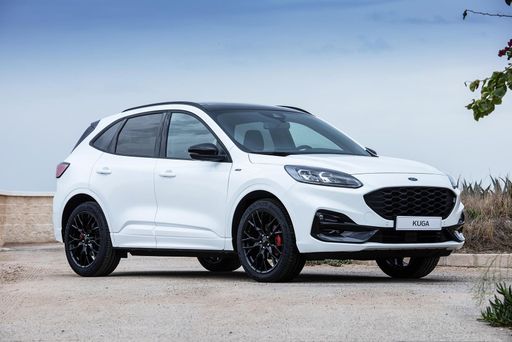 @ Ford Motor Company / Ford Media Center
@ Ford Motor Company / Ford Media Center
Ford Kuga
Ford Kuga
The Kuga is Ford’s adaptable family SUV that blends usable space with a surprisingly lively driving character, making daily commutes and weekend escapes equally enjoyable. With smart interior packaging, an easy-to-use infotainment setup and composed road manners, it’s a sensible choice for buyers who want a bit of fun without the fuss.
details @ Ford Motor Company / Ford Media Center
@ Ford Motor Company / Ford Media Center
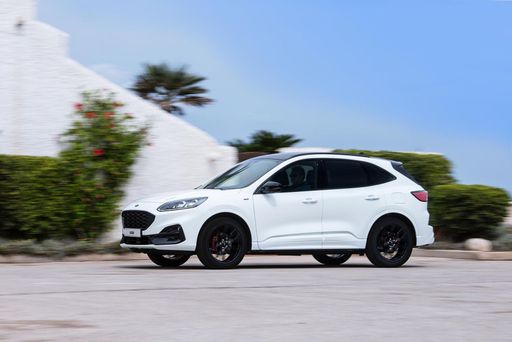 @ Ford Motor Company / Ford Media Center
@ Ford Motor Company / Ford Media Center
 @ Ford Motor Company / Ford Media Center
@ Ford Motor Company / Ford Media Center
Mazda CX-30
The Mazda CX-30 blends sleek coupe-like lines with the practicality of a compact crossover, feeling more premium than its price tag suggests. It’s a joy to drive for anyone who likes a taut chassis and an interior that treats daily commutes like a small luxury escape.
details @ Mazda Motor Corporation
@ Mazda Motor Corporation
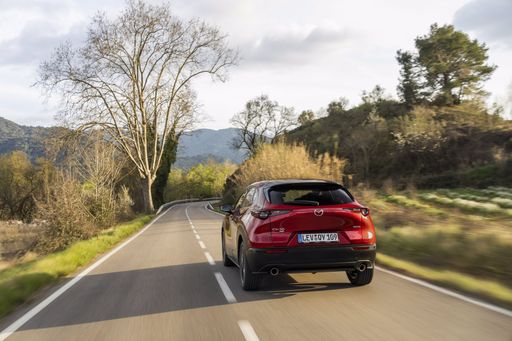 @ Mazda Motor Corporation
@ Mazda Motor Corporation
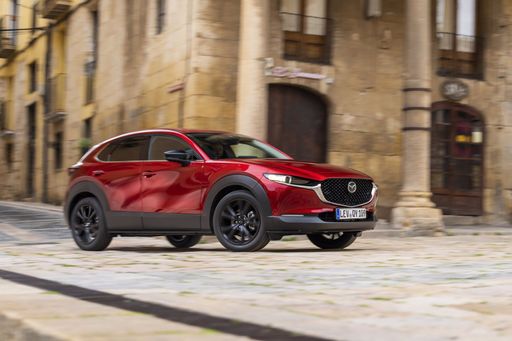 @ Mazda Motor Corporation
@ Mazda Motor Corporation
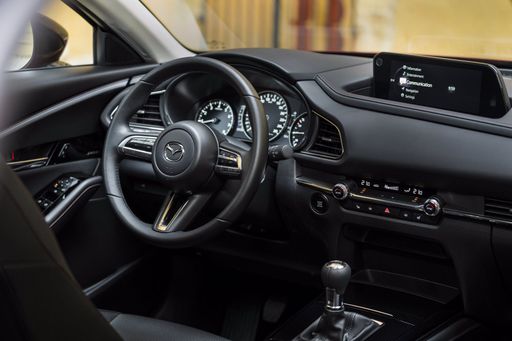 @ Mazda Motor Corporation
@ Mazda Motor Corporation
 @ Ford Motor Company / Ford Media Center
@ Ford Motor Company / Ford Media Center
|
 @ Mazda Motor Corporation
@ Mazda Motor Corporation
|
|
|
|
Costs and Consumption |
|
|---|---|
|
Price
34200 - 46300 £
|
Price
25200 - 36800 £
|
|
Consumption L/100km
2.8 - 6.8 L
|
Consumption L/100km
5.7 - 6.6 L
|
|
Consumption kWh/100km
-
|
Consumption kWh/100km
-
|
|
Electric Range
68 km
|
Electric Range
-
|
|
Battery Capacity
1.1 - 14.4 kWh
|
Battery Capacity
-
|
|
co2
55 - 154 g/km
|
co2
129 - 148 g/km
|
|
Fuel tank capacity
42 - 54 L
|
Fuel tank capacity
48 - 51 L
|
Dimensions and Body |
|
|---|---|
|
Body Type
SUV
|
Body Type
SUV
|
|
Seats
5
|
Seats
5
|
|
Doors
5
|
Doors
5
|
|
Curb weight
1526 - 1859 kg
|
Curb weight
1455 - 1587 kg
|
|
Trunk capacity
412 L
|
Trunk capacity
422 - 430 L
|
|
Length
4604 - 4645 mm
|
Length
4395 mm
|
|
Width
1882 mm
|
Width
1795 mm
|
|
Height
1673 - 1681 mm
|
Height
1540 mm
|
|
Max trunk capacity
1534 L
|
Max trunk capacity
1398 - 1406 L
|
|
Payload
541 - 550 kg
|
Payload
458 - 496 kg
|
Engine and Performance |
|
|---|---|
|
Engine Type
Petrol, Full Hybrid, Plugin Hybrid
|
Engine Type
Petrol MHEV
|
|
Transmission
Manuel, Automatic
|
Transmission
Manuel, Automatic
|
|
Transmission Detail
Manual Gearbox, CVT, Automatic Gearbox
|
Transmission Detail
Manual Gearbox, Automatic Gearbox
|
|
Drive Type
Front-Wheel Drive, All-Wheel Drive
|
Drive Type
Front-Wheel Drive, All-Wheel Drive
|
|
Power HP
150 - 243 HP
|
Power HP
140 - 186 HP
|
|
Acceleration 0-100km/h
7.3 - 9.9 s
|
Acceleration 0-100km/h
8.3 - 10.3 s
|
|
Max Speed
195 - 200 km/h
|
Max Speed
191 - 204 km/h
|
|
Torque
240 Nm
|
Torque
238 - 240 Nm
|
|
Number of Cylinders
3 - 4
|
Number of Cylinders
4
|
|
Power kW
111 - 178 kW
|
Power kW
103 - 137 kW
|
|
Engine capacity
1496 - 2488 cm3
|
Engine capacity
1998 - 2488 cm3
|
General |
|
|---|---|
|
Model Year
2025
|
Model Year
2025
|
|
CO2 Efficiency Class
E, D, B
|
CO2 Efficiency Class
D, E
|
|
Brand
Ford
|
Brand
Mazda
|
What drivetrain options does the Ford Kuga have?
The Ford Kuga is available as Front-Wheel Drive or All-Wheel Drive.
The prices and data displayed are estimates based on German list prices and may vary by country. This information is not legally binding.
